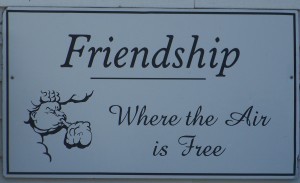Kathy Lynn Emerson's Blog, page 98
August 18, 2015
WHY I WRITE
Vaug hn Hardacker here: Kate Flora’s blog of August 10th hit a note with me. I too had visions of becoming rich at this writing game; then I had my first novel published and my eyes were opened to the reality of the profession.
hn Hardacker here: Kate Flora’s blog of August 10th hit a note with me. I too had visions of becoming rich at this writing game; then I had my first novel published and my eyes were opened to the reality of the profession.
My first shock came when the five or six figure advance I expected was in reality in the low four figures. Unless you have a best seller or two under your belt, the day of the big advance has passed and publishers have become miserly. I suppose if I were a publisher with authors who don’t earn back my advance I’d get miserly too.
My second shock came after the novel was published and I scheduled a whirlwind book tour of Maine. First off, I must say that living in Stockholm and Aroostook County in general makes it tough. The nearest of the chain bookstores is Books A Million in Bangor. I decided to visit the major book stores personally. I met with managers at the BAM stores in Bangor, South Portland, and Auburn. The Assistant Manager in Auburn agreed to a date and the others said they’d get back to me. Result: Auburn called back and said they’d have to reschedule and coordinate with their corporate office and they’d get back to me when they had a date–I’m still awaiting that call. I got no response from Barnes & Noble in Augusta nor the BAM stores in Bangor and South Portland.
Shock number three: I arranged for an appearance at the Caribou Public Library. I thought that since Caribou was my home town I’d get a turn out. Four people showed (2 of whom were members of my writing group) and I sold one (1) book.
Lesson learned: People don’t go to libraries to buy books; they go to borrow them. In fairness, my best turnouts have been at the Jesup Library in Bar Harbor and the Freeport Community Library. Both venues treated me graciously.
I have already blogged about my terrific success at Caribou’s Thursday on Sweden and Maureen Milliken arranged for Lea Wait, her, and me to set up a table at the Maine Artisans Show in Belgrade Lakes. Where we attracted a goodly number of people and sold some books.
So, you ask at this point. If the industry is that tough why do you continue to write?
The answer lies in my history. I grew up in a family–well all I can say is when I watched Father Knows Best, Donna Reed, and Leave It To Beaver I’d look at my parents and ask myself, what’s different here? My parents lived by a simple creedo: Children should be seen and seldom seen. In fact, on those occasions where my younger brother and I were allowed to speak, they didn’t listen (I wonder if someone told them that they had to let us talk, but listening was optional?) In order for me to purge my anger at being stifled, I began writing short stories…on paper no one could tell me what to say–or to shut up.
To this day nothing drives me further up the wall than to be ignored. Heck, I don’t even ask people to agree with me, just listen to what I have to say before discarding it. I’m a writer and writers always have something to say, whether people agree or not.
So here’s the answer: Even if I had never published a single book or short story, I would have kept writing. Why? Because I have to–it’s an integral part of me.
August 16, 2015
WRITER DIES FOR STRAWBERRY PIE
Susan Vaughan here, not dying yet. Maybe I wouldn’t literally die for strawberry pie, but eating the delicious fruit whether au naturel or in a pie is “to die for.” I wrote this post in 2013, but even the weather information applies now. The Maine strawberry season was a little later than usual due to a wet and cool June. The up side of that is the berries had longer to ripen so were larger and sweeter, according to my local produce farmer. And now in August, the ever-bearing berries are ripening.
 Whenever I eat a berry like strawberries or blueberries, I often wonder about the reaction of the first humans to taste them. Ancient peoples must have sampled all kinds of wild plants that either tasted horrible or made them sick. Imagine the euphoria of biting into a juicy berry like the strawberry. Did they wait awhile to see if it made them sick?
Whenever I eat a berry like strawberries or blueberries, I often wonder about the reaction of the first humans to taste them. Ancient peoples must have sampled all kinds of wild plants that either tasted horrible or made them sick. Imagine the euphoria of biting into a juicy berry like the strawberry. Did they wait awhile to see if it made them sick?
A little research, and I found that strawberries are the only berry with seeds on the outside. They grew wild in Italy as far back as 234 B.C. The strawberry was a symbol for Venus, the Roman goddess of love, because of its heart shape and red color. In Othello, Shakespeare decorated Desdemona’s handkerchief with symbolic strawberries. About the strawberry, William Butler (ca 1600) said, “Doubtless God could have made a better berry, but doubtless God never did.”
And early European settlers in Massachusetts ate strawberries cultivated by local Native Americans, who’d cultivated the berry as early as 1643. Crushed berries were mixed with cornmeal and baked into strawberry bread. Colonists then developed their own version and created strawberry shortcake!
In honor of the strawberry, I’m sharing my strawberry pie recipe. It’s easy and foolproof. Oh, and to die for. Enjoy.
STRAWBERRY PIE
Ingredients: 1 quart strawberries, washed, drained, and hulled, a pre-baked and cooled pie shell, 1 cup sugar, 3 tbsp cornstarch, pinch salt, water
Cover cooked pie shell with the choicest berries. Mash 1/2 to 1 cup of remaining berries. Add enough water to make 1 1/2 cups. Mix sugar, salt and cornstarch together. In saucepan, bring juice mixture to boiling. Gradually stir in sugar mixture and cook over low heat, stirring constantly until boiling. Add drop of red food coloring if desired. Boil one minute. Cool. Pour over berries in the pie shell. Chill about two hours. Serve with whipped cream or ice cream. You can use peaches or other berries or a mix of berries.
If anyone has interesting facts or lore about strawberries, please share!
*** All three books of my Devlin Security Force series are available online, for digital readers and in print. Locally in Maine, the print books will soon be available at the Sherman’s Books & Stationery Stores.
August 14, 2015
Weekend Update: August 15-16, 2015
 Next week at Maine Crime Writers there will be posts by Susan Vaughan (Monday), Vaughn Hardacker (Tuesday), Dorothy Cannell (Wednesday), Lea Wait (Thursday) and Barb Ross (Friday).
Next week at Maine Crime Writers there will be posts by Susan Vaughan (Monday), Vaughn Hardacker (Tuesday), Dorothy Cannell (Wednesday), Lea Wait (Thursday) and Barb Ross (Friday).
In the news department, here’s what’s happening with some of us who blog regularly at Maine Crime Writers:
Lea Wait: Busy week coming up! Monday night, August 17, at 7 pm, I’ll be the latest of the Maine Crime Writers to speak as part of the Maine Writers Series at the Witherle Memorial Library in Castine. Looking forward to visiting Castine again, and seeing my friends at the library there!
Then Wednesday, August 19, my husband and I will be at our MAH Antiques booth in the barn at the Maine Antique Dealers Show at Round Top Farm, business route 1 in Damariscotta, from 9 am until 4 pm. This is the only antiques show we do now, since I’m writing and Bob’s painting full-time, but it’s a great show — about 75 dealers, inside and out — and an opportunity for any of you who’ve wanted to see the prints I write about in the Shadows Antique Print Mystery series, from Winslow Homer’s wood engravings to botanicals, birds, military prints … and whatever I pack Tuesday! (If anyone is interested in a particular category or artist .. . contact me before Tuesday and I’ll be sure to bring what you’re looking for.) I’ll also have copies of my books for sale in our booth.
Then Friday night, August 21, Bob and I will be celebrating another opening featuring Bob’s paintings at the Stable Gallery, Water Street, in Damariscotta, from 4 until 7 pm. The opening is part of Damariscotta’s art walk.
An invitation to readers of this blog: Do you have news relating to Maine, Crime, or Writing? We’d love to hear from you. Just comment below to share.
And a reminder: If your library, school, or organization is looking for a speaker, we are often available to talk about the writing process, research, where we get our ideas, and other mysteries of the business. Contact Kate Flora: mailto: kateflora@gmail.com
August 12, 2015
Wet Feet and Leaky Rowboats, or How Not to Research Your Next Novel
Jen Blood here, very excited to be writing my first official post with Maine Crime Writers. To learn more about who I am and the writing I’ve done, you can check out this interview I did with the inimitable Susan Vaughan back in April of 2013. But I thought to get a real idea of who I am and where I come from, I’d take a few minutes here to talk about the day my dad and I took a leaky rowboat out to research the island on which my Erin Solomon series is based. And nearly drowned.
It was 1998 or ’99 when I was getting the lay of the land while I wrote All the Blue-Eyed Angels, the first novel in the Solomon series. In the book, there’s an alleged cult suicide on an island a few miles from Littlehope, Maine — a town based on a midcoast fishing village called Friendship. Naturally, that meant I needed to find an actual island in the vicinity so that I could get the flora and fauna and general creepy vibe just right. Conveniently enough, Friendship Long Island is less than a mile from the Friendship pier, and seemed to suit my purposes beautifully.
Since I had no boat, however, I decided to ask my dad to give me a hand finding one so that we could go out some afternoon and check out the island. Being the good dad that he is, he agreed.
So, now, a little background on my father: Originally from Massachusetts, my dad is a not-terribly-tall man with a booming voice and a big laugh and a penchant for finding trouble whether he’s looking for it or not. He’s got a good heart, but not a lot of patience for the mundane practicalities of everyday.

Jen with Dad circa 1995, Peaks Island.
I arrived at the Friendship pier at around 8:30 in the morning on the day we were to head over to the island. Somehow I had thought my dad would be able to find an actual boat boat — with a motor, maybe even a cabin. I don’t know where I thought he’d get that boat, but it’s what I’d gotten in my head. Instead, on an overcast morning in June, I showed up to find my old man waiting for me in a leaky rowboat with one life preserver.
“You ready, Jenny? I think this thing’ll float,” said he.
But because I truly am my father’s daughter, and I really did want to get out to that island, I agreed that it looked generally seaworthy… and Friendship Long Island was less than a mile out. What could possibly go wrong?
It was cool and overcast that day, as early June often is in Maine. I had a disposable camera with me, and Dad rowed while I took shots of harbor seals and whitecaps, all the while bailing out the growing pool of water at my feet with a plastic gallon jug.
It was high tide when we reached the island. The fog had lifted and the sun was strong — which was good, because my toes had gone numb after having been submerged in seawater for the full trek out. Neither Dad nor I had thought to bring food. Or water. Or a map. We found a rough trail and I continued to take pictures, plotting in my mind where the Payson Church might have stood, or what the wind might have been like on the day it burned to the ground.
Friendship Long Island is about three miles long — a lot of that rough terrain and thick brush, especially back in ’99. I honestly remember very little of the island itself. I know that we came upon a house at one point, and Dad knocked on the door and someone let us in. I remember in a hazy sort of way that I asked some questions about the island and whoever we came across answered and my father beamed because I was a Writer and we were Researchers, doing what Researchers do. I remember picking berries. I remember getting a sunburn. And then, I remember that the clouds had returned and the winds had picked up and we needed to get going if we ever hoped to make it back to the mainland.
We set out.
In case you’re not familiar with the open seas, a rowboat on the ocean isn’t the ideal way to travel, at least not to my way of thinking. For one thing, rowboats are cumbersome beasts – tough to topple, true, but they make any trek in rough water a slog. When you’re in a rowboat on rough water and the seas are getting dark and the skies are getting darker and, for all intents and purposes, there is a hole in the bottom of your boat, that slog becomes downright menacing.
By the time we were about three quarters of the way back to the mainland, we’d taken on way more water than I could feasibly bail out. My legs were submerged to the knees, as were Dad’s. It started to rain.
“You think anybody else has adventures like us?” I remember my father asking me then. My teeth were chattering. I was fairly sure we’d have to swim if we ever wanted to hit dry land again. My disposable camera had fallen in the water at some point in the journey, and the film ultimately proved unusable. I shook my head.
“I’m pretty sure anybody else would’ve had the sense to get a bigger boat.”
He laughed – that big, booming laugh that should come from a much larger man. “That’d make for a boring story, don’t you think?” he said.
Seventeen years later, I usually remember things like water and snacks and an extra pair of dry socks when I’m headed into the wild blue. I don’t go out in the open ocean in leaky rowboats. My dad is 71. He’s hard of hearing. He has high blood pressure, and COPD from a lifetime of smoking two packs a day — a habit he kicked a couple of years ago. He, too, tends to avoid leaky rowboats these days. The value he’s always placed on a good story, however, continues to stick with me. Given the choice between that and dry feet, I still think I’d have to pick the story.
August 11, 2015
Making Writing Space
What happens to me when I cross the Piscataqua and plunge rapidly into Maine at a cost of seventy-five cents in tolls? I cannot describe it. I do not ordinarily spy a partridge in a pear tree, or three French hens, but I do have the sensation of having received a gift from a true love. And when, five hours later, I dip down across the Narramissic and look back at the tiny town of Orland, the white spire of its church against the pale-red sky stirs me in a way that Chartres could never do.”—E.B. White, Home-Coming, 1955
I am lucky enough to live in Maine all the time and don’t have to cross the Piscataqua to make a pilgrimage to Allen Cove in Brooklin, Maine, where the incomparable E.B. White lived and wrote for so many years.

E.B. White
But just as he did on his long rides from away, I feel a delicious anticipation when crossing the Narramissic River in the Hancock County town of Orland. From there it’s less than a half hour to the shore of Allen Cove, where I also lived once upon a time. My period of residence began eight years after the 1985 death of the famed essayist, author and authority on writerly style.

The gravestones of two amazing writers, Katharine and E.B White, in the Brooklin cemetery
In the mid-90s I lived in a rented cottage on the south side of E.B. and Katharine White’s former hayfield, across the road from their old saltwater farm. Though I had turned in my journalist’s badge by then, I still thought of myself as a writer, self-identity being a fairly fixed thing by the time you’re thirty-something. I was a recent law school grad, and had yet to realize that the legal and literate sides of my brain could sing—or at least hum—in harmony. Though the writer part of me was in a fallow period, I thought a lot about the man who used to live across the road. I bought and read as much of his work as I could find. (I later discovered Katharine White’s work, which is a blog post for another day.)
The summer folks who had bought the Whites’ farm urged me to hike around on the farm throughout the winter, and even loaned me a pair of snowshoes for that purpose. Without the smell of humans on the land, the deer would decimate the orchard, they said, so tromp around to your heart’s content. That’s how the Whites’ former place became mine to ramble during the cold weather months 20 years ago.
I was especially drawn to the converted boathouse on the shore of Allen Cove where E.B. White wrote. I spent considerable time peering through the window of his former writing space, studying its spare beauty.
Here’s how he described it:
The house in which I sit this morning was built to accommodate a boat, not a man, but by long experience I have learned that in most respects it shelters me better than the larger dwelling where my bed is, and which, by design, is a manhouse, not a boathouse. Here in the boathouse I am a wilder and, it would appear, a healthier man, by a safe margin. I have a chair, a bench, a table, and I can walk into the water if I tire of the land . . . A mouse and a squirrel share the house with me. The building is, in fact, a multiple dwelling, a semidetached affair. It is because I am semidetached while here that I find it possible to transact this private business with the fewest obstacles.—E.B. White, A Slight Sound At Evening, 1954.
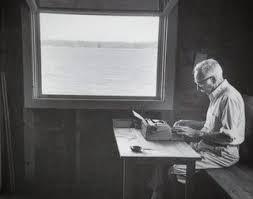
Semidetached in the boathouse
My visits to his former coveside writing space occurred at a time when I was unable to achieve the semidetachment necessary to make up my own stories. Yet I yearned for a physical and mental writing space of my own, on the shore of Allen Cove or any other shore for that matter. I was learning to be a lawyer in rural Maine, but my new profession still felt like playacting, and part of me wanted to be offstage, writing the lines.
Two decades later I have figured out that I’m capable of doing both. I am a lawyer and a crime writer. My writing space is nothing like the boathouse into which I peeked on those cold afternoons on the shore of Allen Cove. But like White, I write every day, and feel as though I’ve received a gift when I cross that little river on the journey back to Brooklin.

A blueberry pie is always a gift
This year, two days after I delivered the manuscript for my third Joe Gale mystery, we pointed the car north and east and yelped with joy when we crossed the Narramissic. We only had a week, but boy, did we make the most of it in a modest rented cottage around Allen Cove from the Whites’ place.

Allen Cove at sunset, August, 2015
We ate lots of blueberry pie. Took looooong swims in the cove when the tide was high. Hiked through hushed woodlands. Ate more pie. Sat in awe of sunsets that went on for an hour. Watched a gang of greater yellowlegs dance along the shore. Listened for the nightly hermit thrush serenade while doing the supper dishes. Slept with the windows wide open to welcome the cool night breeze off the water. Ate still more pie.

A greater yellowlegs sashaying along the shoreline
And every now and then I picked up the binoculars and reconnoitered the shoreline of the cove until E.B. White’s little boathouse came into focus, still standing for the proposition that every writer needs to find their own space to write.
Brenda Buchanan is as happy as a clam at high tide to be attending the Murder By The Book conference at Jesup Memorial Library in Bar Harbor on September 18-19. Any excuse to cross the Narramissic . . .
August 10, 2015
Murder without the Gore: Part I
Kathy Lynn Emerson/ Kaitlyn Dunnett here, chiming in on that ever popular topic of categorizing mystery novels. I’m breaking this down into three parts—there is no way to cover everything in one post of reasonable length. The text in all three is an updated version of a workshop I gave at the 2015 Maine Crime Wave.
Let me just say first that I hate labels. They are the invention of booksellers and publishers. Unfortunately, writers are stuck with them. That means we have to try to understand what those labels mean if we ever hope to have our novels published and made available to the general public.
 When I wrote How To Write Killer Historical Mysteries, I devoted the entire first chapter to definitions. It could have been twice as long as it is. It can also be ignored in favor of getting down to the nuts and bolts advice that begins at chapter two. My point is that, as much as I’d like to be able to skim lightly over definitions, we’re stuck with them. There is no way to talk about “traditional mysteries” without defining both the genre and its subgenres.
When I wrote How To Write Killer Historical Mysteries, I devoted the entire first chapter to definitions. It could have been twice as long as it is. It can also be ignored in favor of getting down to the nuts and bolts advice that begins at chapter two. My point is that, as much as I’d like to be able to skim lightly over definitions, we’re stuck with them. There is no way to talk about “traditional mysteries” without defining both the genre and its subgenres.
The subgenres are what cause most of the trouble, especially the one labeled “cozy.”
In the broadest sense, the two ends of the mystery spectrum go by the names “hard boiled” and “traditional.” There’s obviously a lot of territory in between. Since I’m looking at the traditional end, let me quote the official definition used by the Malice Domestic convention in determining what works are eligible for the Agatha award for traditional mysteries. It has two parts. First, “books best typified by the works of Agatha Christie” and second, “a genre loosely defined as mysteries which contain no explicit sex or excessive gore or violence.”
That’s it, but those two guidelines cover a lot of territory, especially when you remember that Christie created Poirot, Tommy and Tuppence, and a quite a few stand-alone detectives, as well as Miss Marple. If you take a look at the books that have been finalists for the Agatha award over the years, you’ll see that they cover a wide spectrum.
 This year, in contemporary novel, there were The Good, the Bad, and the Emus by Donna Andrews, A Demon Summer by G. M. Malliet, Truth be Told by Hank Phillippi Ryan, The Long Way Home by Louise Penny, and Designated Daughters by Margaret Maron. In historical novels, the finalists were Queen of Hearts by Rhys Bowen, Wouldn’t it be Deadly by D. E. Ireland, Murder in Murray Hill by Victoria Thompson, and two books, one from each series, by Malice Guest of Honor Charles Todd, Hunting Shadows and An Unwilling Accomplice. Other recent finalists include Maine authors Barbara Ross and Julia Spencer-Fleming. You can go online to see twenty-seven years worth of traditional mysteries that were finalists for the Agatha.
This year, in contemporary novel, there were The Good, the Bad, and the Emus by Donna Andrews, A Demon Summer by G. M. Malliet, Truth be Told by Hank Phillippi Ryan, The Long Way Home by Louise Penny, and Designated Daughters by Margaret Maron. In historical novels, the finalists were Queen of Hearts by Rhys Bowen, Wouldn’t it be Deadly by D. E. Ireland, Murder in Murray Hill by Victoria Thompson, and two books, one from each series, by Malice Guest of Honor Charles Todd, Hunting Shadows and An Unwilling Accomplice. Other recent finalists include Maine authors Barbara Ross and Julia Spencer-Fleming. You can go online to see twenty-seven years worth of traditional mysteries that were finalists for the Agatha.
 Protagonists include law enforcement personnel and private detectives as well as amateur sleuths. The setting is anywhere and in any time period. There can even be paranormal elements. Donna Andrews won an Agatha some years back for a novel in which the sleuth was a computer with artificial intelligence.
Protagonists include law enforcement personnel and private detectives as well as amateur sleuths. The setting is anywhere and in any time period. There can even be paranormal elements. Donna Andrews won an Agatha some years back for a novel in which the sleuth was a computer with artificial intelligence.
The plots usually involve one or more murders, but some traditional mysteries deal with lesser crimes. Once in a great while, a traditional mystery will end with the revelation that no crime at all has been committed, but there will be closure for both the reader and the characters by the end of the book. Solving the mystery, the puzzle, is actually more important that what laws may have been broken. Unlike real life, things are resolved, usually well for the good guys and badly for the villains.
These days, many traditional mysteries are marketed under the label “cozy.” What is a cozy? There’s a whole lot of debate about that, but in the most general sense it is a traditional mystery on the lightest end of the scale. Some who like their mysteries to have a harder edge will sometimes use the term in a derogatory way. That’s not difficult to do when so many cozies have similar warm, fuzzy elements. There is a fine line between clever and cutesy.
 In most cozies, the murder is solved by an amateur sleuth whose hobby or occupation—owning a specialty store of some sort is popular—brings him or her in contact with the crime. There is a confined setting, often in a small town, a closed community, or a place such as a country house or a hotel, that is temporarily cut off from the rest of the world by, say, a blizzard. But there is also such a thing as an urban cozy—set in a city but with characters who already know each other. A recent offering of this type is set in a spice shop near Seattle’s Public Market.
In most cozies, the murder is solved by an amateur sleuth whose hobby or occupation—owning a specialty store of some sort is popular—brings him or her in contact with the crime. There is a confined setting, often in a small town, a closed community, or a place such as a country house or a hotel, that is temporarily cut off from the rest of the world by, say, a blizzard. But there is also such a thing as an urban cozy—set in a city but with characters who already know each other. A recent offering of this type is set in a spice shop near Seattle’s Public Market.
There are often humorous elements in cozies. These are usually in the form of eccentric characters who provide comic relief. There are also, almost always, animals and/or children, most frequently of the feline persuasion. The majority of cozies are written in first person from a single point of view . . . but not all. My own Liss MacCrimmon books are written in third person. The number of point of view characters varies from book to book. In one, I used only Liss. In most I also let you into the minds of her gal pal, Sherri, who is conveniently employed in law enforcement, and her love interest and later husband, Dan, who is not.
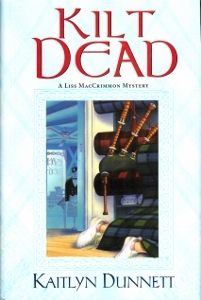 I’ve always said I write cozies, both with my three historical series and in the Liss MacCrimmon mysteries set in Moosetookalook, Maine. In the latter, Liss owns Moosetookalook Scottish Emporium. There are lots of eccentric characters, both among the townspeople (population 1007) and among the guests at the grand hotel on the outskirts of town. There are two cats.
I’ve always said I write cozies, both with my three historical series and in the Liss MacCrimmon mysteries set in Moosetookalook, Maine. In the latter, Liss owns Moosetookalook Scottish Emporium. There are lots of eccentric characters, both among the townspeople (population 1007) and among the guests at the grand hotel on the outskirts of town. There are two cats.
That said, I’ve received emails from a number of readers writing to tell me that don’t consider my books to be true cozies. Their reasons vary. One is that I put my sleuth in too much danger. Another is that she occasionally swears when she’s upset. And, a third is that, horror of horrors, I occasionally refer, in passing, to the fact that Liss has a sex life.
Other series that carry the cozy label commit these same sins, some of them to a greater degree than I do. In fact, I recently heard from a reliable source that there is at least one editor actively seeking “cozies with sex.” Go figure!
I’ll have more to say on this subject when I blog again on August 26th. Stay tuned.
Kathy Lynn Emerson/Kaitlyn Dunnett is the author of over fifty books written under several names. She won the Agatha Award in 2008 for best mystery nonfiction for How to Write Killer Historical Mysteries and was an Agatha Award finalist in 2014 in the best mystery short story category for “The Blessing Witch.” Currently she writes the contemporary Liss MacCrimmon Mysteries (The Scottie Barked at Midnight) as Kaitlyn and the historical Mistress Jaffrey Mysteries as Kathy (Murder in the Merchant’s Hall). The latter series is a spin-off from her earlier “Face Down” series and is set in Elizabethan England. Her websites are www.KaitlynDunnett.com and www.KathyLynnEmerson.com
August 9, 2015
Can You Afford to Get Published?
 Kate Flora here, with a question I’ve been pondering on this week. Usually, published writers like to paint a glowy picture of the world we inhabit. It is true that, having struggled often for years to finally become published, we are grateful for the chance to get our work out there and have it read, and I beam with pride when I look at my row of published books. But this week, after putting together some figures for the past twelve months, I estimate that I’m working for about a dollar a day. I thought it might be interesting to readers to have some insight into the published author’s reality.
Kate Flora here, with a question I’ve been pondering on this week. Usually, published writers like to paint a glowy picture of the world we inhabit. It is true that, having struggled often for years to finally become published, we are grateful for the chance to get our work out there and have it read, and I beam with pride when I look at my row of published books. But this week, after putting together some figures for the past twelve months, I estimate that I’m working for about a dollar a day. I thought it might be interesting to readers to have some insight into the published author’s reality.
I published my first mystery, Chosen for Death, back in 1994. For those early books in my Thea Kozak series, the advances ran around $5-6,000, and I usually earned royalties on top of that. For those of you who aren’t familiar with the way publishing works, when a publisher buys a book, they usually give the writer an advance of some amount that will be offset against the amount of money the work ultimately earns. Often this is divided with some money due on signing the contract, and another part due when the book is actually published, which may be a year or more down the road.
 I puttered along with my advances in this range until I sold my breakthrough book, Steal Away, (published as Katharine Clark) which had a big advance, was a book club selection, and was sold as an audio book. The book did not earn back that big advance and so, since publishers considering buying a book look at sales numbers, my happy midlist career was ruined.
I puttered along with my advances in this range until I sold my breakthrough book, Steal Away, (published as Katharine Clark) which had a big advance, was a book club selection, and was sold as an audio book. The book did not earn back that big advance and so, since publishers considering buying a book look at sales numbers, my happy midlist career was ruined.
But I am stubborn, so I kept on writing, and eventually sold my Joe Burgess series. Some time had passed and the advances had gotten smaller. Then I sold my first true crime, Finding Amy, to a university press. Another small advance that I shared with co-writer, Joe Loughlin.
And so it has gone. Selling something it has taken a year or more to write for a few thousand dollars does not seem like a sensible economic model.
Last year, I had two books published, my second true crime, Death Dealer: How Cops and Cadaver Dogs Brought a Killer to Justice, which I had worked on for five years, and the fourth Joe Burgess. The advances, combined, didn’t add up to the $6,000 I used to receive.
There are a lot of expenses involved in promoting a book. Many readers (and even writers aspiring to be published) don’t realize how many expenses are not covered by the publisher. For example: designing and maintaining a website, designing and printing publicity materials like flyers and bookmarks, buying copies of the book to give to people who’d helped me during the writing process, and buying copies of galleys to mail out for reviews, along with the expenses of the 3000 miles I put on my car.
And that’s not all. I was lucky enough to have Death Dealer be named an Agatha finalist, so I attended the Malice Domestic conference in Bethesda in June, along with Sleuthfest in Florida in February. With airfare, hotels, and registration, a conference can easily cost a thousand dollars. In addition, I decided to take a chance on hiring a publicist to see if I could break out and get my books greater recognition.
Even when a book earns royalties, publisher routinely pay them only once or twice a year, and usually several months after the money has been earned, and traditionally hold back part of those earnings “against returns.”
So here I sit, nearly a year after my books have been published. The writing community has been generous. Death Dealer is an Agatha and Anthony finalist, and won the Public Safety Writers Association 2015 award for nonfiction. And Grant You Peace won the 2015 Maine Literary Award for Crime Fiction. I am humbled at the recognition and deeply grateful to my peers.
I have received nothing beyond those initial advances.
I am deeply in the hole, though I am lucky enough to have my backlist available as e-books, which brings in some steady income.
Obviously, I am not going to stop writing, and neither should you. But you should be warned: despite the honor of the thing, unless you have a best-seller, it is hard to make a living at this. That’s why we speak and teach and do manuscript reviews and a zillion other things and why we tell aspiring writers: don’t quit your day job, or be lucky enough to have a partner with benefits.
August 7, 2015
Weekend Update: August 8-9, 2015
 Next week at Maine Crime Writers there will be posts by Kate Flora (Monday), Kaitlyn Dunnett/Kathy Lynn Emerson (Tuesday), Brenda Buchanan (Wednesday), Jen Blood (Thursday) and Jayne Hitchcock (Friday).
Next week at Maine Crime Writers there will be posts by Kate Flora (Monday), Kaitlyn Dunnett/Kathy Lynn Emerson (Tuesday), Brenda Buchanan (Wednesday), Jen Blood (Thursday) and Jayne Hitchcock (Friday).
In the news department, here’s what’s happening with some of us who blog regularly at Maine Crime Writers:
from Kathy Lynn Emerson: The October issue of Alfred Hitchcock’s Mystery Magazine goes on sale on Tuesday, August 11. Why is this news? Because it includes the second “Old Mother Malyn” short story, “The Cunning Woman,” set in Elizabethan England. The first of Malyn’s adventures, related by her granddaughter and apprentice, Joan, was “The Blessing Witch,” a finalist for last year’s Agatha Award for best mystery short story. My fingers are crossed that readers like this one as well.
from Barb Ross: Barbara Ross’s multi-state, I-forgot-to-do-a-tour-when-Musseled-Out-came-out Book Tour continues.
Tuesday, August 11, at 7:00 pm I’ll be appearing with Edith Maxwell and Liz Mugavero at Porter Square Books in Cambridge, MA
Thursday, August 13, at 7:00 pm, I’ll be at the Vose Library , in Union, ME.
That’s the end of the tour until after my knee surgery in September.
In other news, I received the happy news that Boiled Over, the second Maine Clambake Mystery, is being reprinted. Thank you Maine booksellers (three of whom discovered it was out of stock and let me and Kensington know).
An invitation to readers of this blog: Do you have news relating to Maine, Crime, or Writing? We’d love to hear from you. Just comment below to share.
And a reminder: If your library, school, or organization is looking for a speaker, we are often available to talk about the writing process, research, where we get our ideas, and other mysteries of the business. Contact Kate Flora: mailto: kateflora@gmail.com
August 6, 2015
Keep one eye open for the dark world outside your window
Hi all. Maureen Milliken here.
Of the many things I love about my house, the large windows in my bedroom that overlook my narrow street and the tangle of woods across the street top the list. They face west, and in the evening when the sun is going down, the room glows. There trees across the street take on a different character every day of the year and the fascinating show from the huge windows changes with the seasons. I feel like I live in a tree house.

The summer morning view out the window.
But what I really like is lying in bed at night — I’m a light sleeper and it usually takes some time for me to fall asleep — and seeing the trees outside, the moon filtering through. This time of year all the windows are open, and I fall asleep listening to the loons and owls and occasional tractor-trailer rig barreling down Route 27.
Last night I was lying awake (something about knowing I have to get up earlier than I’ve ever voluntarily gotten up in my life, to write, makes it hard to fall asleep), when my faithful cat, on the bed next to me bristled and growled. She did it very lightly, almost tentatively, but that just made more eerie. I opened my eyes and looked out the window — I don’t have to to move to do it, it’s right there — and saw something gliding down the middle of the street.
It was too big to be a cat and didn’t move like a dog. Gliding is the only word for it. Without my glasses on and with only the light from the almost non-existent moon and my neighbor’s porch, I couldn’t even begin to tell what it was. It seemed light colored, long, thin. Maybe a coyote? It didn’t bob or sway. It wasn’t running, but it was moving swiftly and soundlessly.
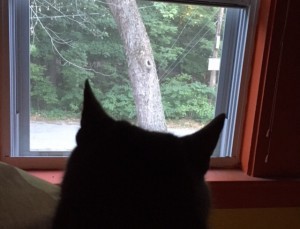
Binti always keeps a close watch on the other world outside the window.
My cat, Binti, and I watched as it disappeared down the block, a strange interlude in our night.
The other day I wrote a column for the newspapers I work for about the “real” Maine, the one largely hidden from summer visitors. About the strange little dance we do between our reality and their fantasy, and how little they know of what goes on in our towns, in the woods and behind closed doors.
But as I watched that apparition disappear down my narrow lane, I thought how little even those of us who live here really know about what’s going on around us. Our towns are carved out of tangled woods, jammed in between the rocks, the mountains and the lakes. We’re surrounded by natural forces that we see, but just the surface. There’s a whole world going on right under our noses that we rarely think about and are mostly oblivious to. But I don’t think it’s oblivious to us.

The view out my window is fascinating any time of year.
As I watched that long thin shape soundlessly glide down the street last night, I knew it was aware of our world. Not that it was interloping, but that we were, and once we’re put away for the night, it’s free to take it back.
Now there’s something to keep me up at night.
Maureen Milliken is news editor of the Morning Sentinel and Kennebec Journal. Her mystery novel, Cold Hard News, the first in the Bernie O’Dea mystery series, was released in June.
August 5, 2015
Questionable Behavior
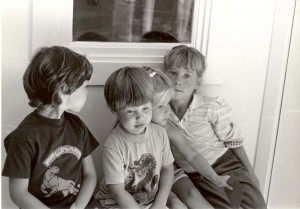
Jake, Max, Lisa and Sara when they were really young, sitting on Grandma Clark’s front steps
John Clark pondering whether to get a ouija board or go to a psychic. I’m thinking about all the unanswered questions that have accumulated over the years, the ones I was too young, too in a hurry, too self-centered, or too sure there would be a time in the future, to ask. If you take a few moments, I’ll bet you can put together the beginnings of a pretty important/interesting batch yourself. Looking back over my life, I have to agree with Mark Twain. Youth IS wasted on the young. If that wasn’t true, every kid who grew up in the 1950s and 1960s would have bought plastic sleeves and carefully inserted those comic books and sports cards in them instead of inserting the cards between bicycle spokes and riding hell-bent through mud puddles. Likewise, we wouldn’t have spilled chocolate milk or strawberry soda all over issue #1 of Weird Tales. Ah, well.
Seriously though, I really wish I’d had my act together to ask some questions or pay better attention when my now departed relatives took the time to talk to me. Granted there were some, like my grandfather Clark, who died before I was old enough to even contemplate asking questions, but most everyone else hung around long enough so I might have gathered a mother lode of interesting and enlightening information and family history. Even so, it didn’t really hit me until after Mom died and I’d catch myself trying to remember something about growing up or some fragment of a memory that I knew I couldn’t be able to unlock without asking her and by then, that was impossible.

My father and my grandmother Della
I’m sharing some of the questions I will probably never have answers to and doing so for a couple reasons. First, I hope you can ponder them to get a sense of what I’m missing and then put together your own list. I suspect that some of you will figure out pretty quickly that you have an ‘impossible’ list equal to mine. That goes with the reality that many of us who read and/or blog here are up there in age and let’s be honest, the relative making machine isn’t working so well any more. However, by sharing this maybe some of you will realize that a resource for one (or more) of those ‘I was gonna get around to asking it’ questions is still accessible. I’d be very interested in hearing from anyone who gets lucky.
Growing up, my favorite relative was my great uncle, Leland Look, particularly when I was in my late teens and early twenties. He and Aunt Ruby lived in a big house on the corner of Rt. 27 and High Street in New Vineyard. He was postmaster there for a long time and was my grandmother Della Look Clark’s baby (and only) brother. I used to do a lot of brook and river fishing for trout in those days and whenever I wanted a fishing partner, Leland was ready to hop in my truck and off we’d go. We used to fish the west branch of the Carrabasset, more commonly known as Salem Stream, often starting just down the hill from where Mount Abram High is located. There was a stretch of close to two miles where the stream wandered through wilderness with no camps or houses. Sometimes we saw beaver or deer and once when I fished it by myself after he died, I was returning via an old woods road and nearly kicked a young bear in the rear while he was ripping open an ant hill.
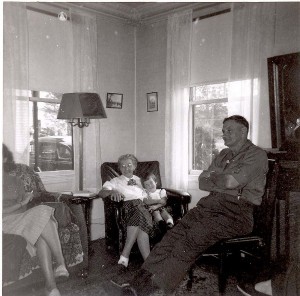
My grandmother, me and her ‘baby’ brother Leland
Anyhow Leland and Ruby were as good as it gets for making you feel welcome and appreciated, feelings that I seldom experienced at home in those days. It didn’t matter what time of day or night I arrived, I was met with a smile, food, hot coffee and on occasion a warm bath and a clean bed. In addition to being a postmaster and avid fisherman, Leland loved to raise dinner plate dahlias. In fact I’m surprised more accidents didn’t happen in late summer due to tourists getting distracted by the wall of giant flowers that followed the porch around two sides of the house. He was also an excellent hunter and trapper. If memory serves me, he had the antlers from one of his big bucks mounted in the woodshed and it was twenty points of more.
I was too messed up to get out of my own head back then, so despite the warmth and affection Leland and Ruby showered on me, I didn’t tend to stat around and chat nearly as often as I should have. As a result, I never got to ask Leland what it was like for him growing up with four sisters and what he could tell me about the Look family. Granted, my mother did a heck of a lot of work putting together a family tree chart (well before the days of online searching), but those are never as satisfying as hearing someone talk about a great great uncle as they personally remembered him. My biggest lament is that with all the brook and river fishing we did together, I never bothered to ask him the one thing that made him stand out from the other fishermen in the area. Leland seldom, if ever got skunked on Porter Lake where he and Ruby had a camp. He’d head out in his canoe with his electric trolling motor and an hour later, he’d be back with a decent togue, sometimes more than one. I’d love to know where and how he did it.
Most of my unanswered questions reside on that side of the family, mainly because Mom’s kin lived in upstate New York, so we weren’t nearly as well connected. However, if I could hop in the wayback machine and go to Old Forge, I’d ask my grandfather Earl Carman what it was like growing up with an identical twin brother. I’d also ask him about some of the more famous sports he let through Bisbee Gate, the access point to a huge private reserve. He and my grandmother Martha lived in the gatehouse and controlled access for a very long time and I’m sure they had more than their share of diplomats, royalty and celebrities pass through at one time or another.

My maternal grandparents, Martha and Earl Carman with Mom and her three brothers at the 50th wedding anniversary party
Another mystery I’d like to solve, at least partially, would have involved asking my paternal grandmother Della what she remembered about my grandfather finding the big gold nugget I used to get to hold when I was a kid. Supposedly he found it while fly fishing the north branch of the Dead River, but I bet she knew at least a little bit about his favorite spots on that stretch of water. I’d love to hit them with my new metal detector.
If I could, I’d have set aside my animosity toward my father and asked him to share some of his experiences during World War II. He was a forward artillery spotter with the 45th Division and I know he saw some hellish stuff because he had a photo album I found when I was about ten and it contained some really shocking pictures from one of the death camps he helped liberate.
Even my mother who I spent many hours talking to, especially after we both got sober, died with answers I really wish I had. I have a letter in my desk from some Australian cousins. Unfortunately, it’s from the late 1960s and despite the miraculous things one can find online, I’ve hit a dead end in terms of tracking them down. Another mystery is a great great aunt or grandmother who was quite probably manic as well as wealthy. After her husband and my namesake (probably John Rogers Clark III) died, she loaded her fancy car onto a steamship and took off for Europe with a new beau. She and her fortune were never heard from again, although I remember Mom saying something about her ashes arriving in a fancy urn a few years later. If I’d been more persistent, maybe I’d have enough information in one or both instances so I could make a little progress.
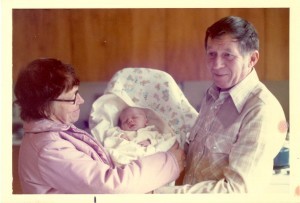
My parents with their first granddaughter Sara Beth
Of course, the flip side of these laments is what they have taught me in terms of sharing stuff with my children, and I hope with granddaughter Piper when she’s a little older. Both girls came with me to a lot of AA meetings in the early part of my recovery, especially when Beth had to work on a Monday holiday. That was because I set up the Monday Noon Eye-opener meeting at AMHI, so I had to bring the kids along. You can never be completely surprised by what children absorb about things like recovery. There was a stretch of several years where every time we drove along Route 17 as it passed Chickawaukee Lake in Rockland, they’d look at me and say, “That’s the one you drove your car into, dad?” I’d nod and smile because it was good for them to know a bit of what it was like for me before they were born and how different things are now.
I’d be very interested in hearing some of the things you still wonder about because you never got the chance to ask. I also leave you with the thought that every unanswered question is an opportunity to create a dandy short story.


